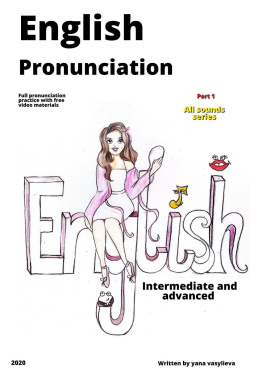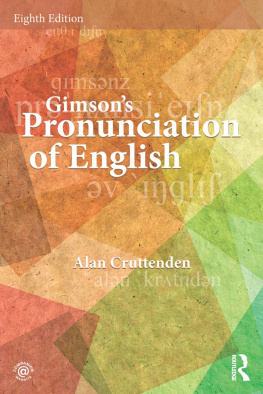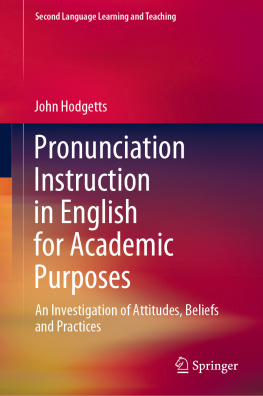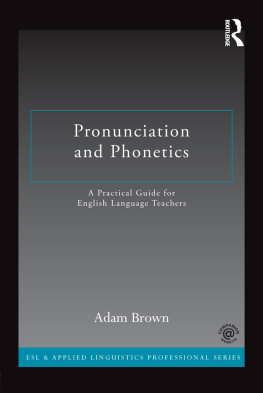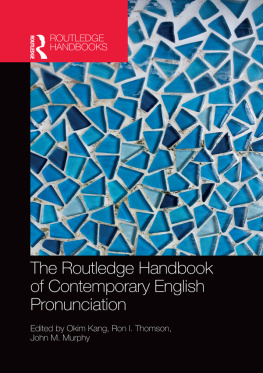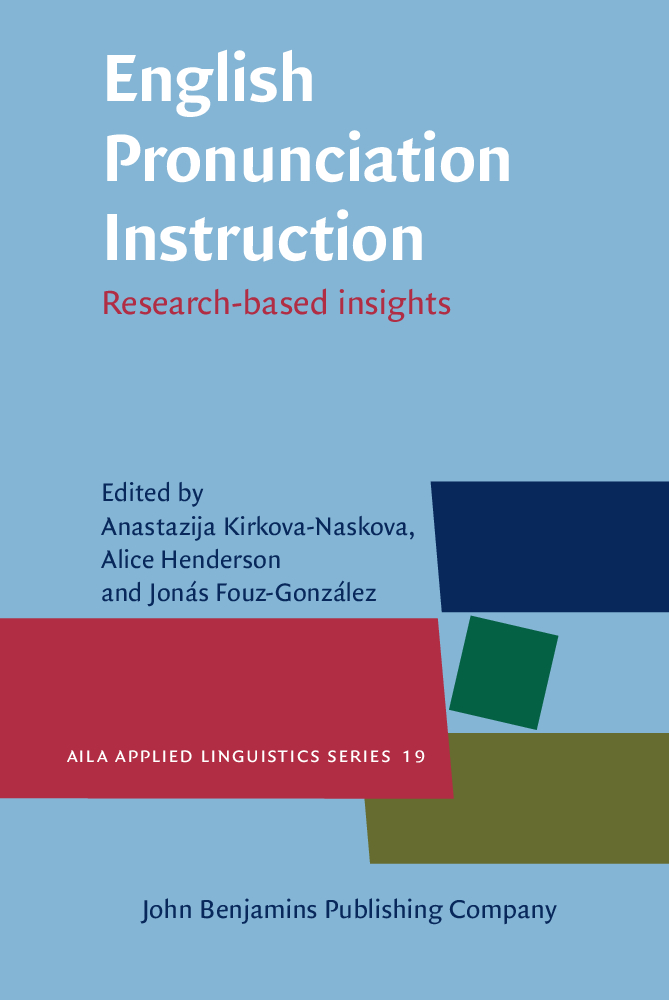

English Pronunciation Instruction
Research-based insights
Anastazija Kirkova-Naskova , Alice Henderson & Jons Fouz-Gonzlez Ss. Cyril and Methodius University, Skopje | University of Grenoble-Alpes | University of Murcia
doi: 10.1075/aals.19
ISBN: 978 90 272 5907 3 (ebook)
Cataloging-in-Publication Data available from Library of Congress:
LCCN 2021026187
2021 John Benjamins Publishing Company
John Benjamins Publishing Company https://benjamins.com
List of tables
Questions to guide reflection on the pedagogical applicability of research findings
Findings from Munro and Derwing (2006) regarding functional load
Research questions
The relationship between self-perceived accent strength and a sense of satisfaction (Q12 and Q13)
Frequency of SA and FA of pronunciation with different tasks and aspects of pronunciation
An overview of Tasks 16 for Pronunciation Learning
Descriptive statistics for the participants scores on Six Tasks
U Mann-Whitney test results for high- and low-achievers mean scores on the Six Tasks
Task 1: Vowel identification responses by High- (HA) and Low-Achievers (LA)
Task 2: IPA-to-orthography responses by High- (HA) and Low-Achievers (LA)
Task 3: Vowel matching responses by High- (HA) and Low-Achievers (LA)
Task 4: Minimal pair matching and providing vowel symbols responses by High- (HA) and Low-Achievers (LA)
Task 5: Identifying letters representing vowels or diphthongs responses by High- (HA) and Low-Achievers (LA)
Task 6: Identifying schwa in a sample text responses by High- (HA) and Low-Achievers (LA)
Extract from AixOx (Text T10)
Communicative framework for teaching English Pronunciation (adapted from Celce-Murcia et al., 2010)
Generalised linear mixed effects model for onset consonant clusters
Number of responses and relative frequencies of strong, weak, and mispronounced forms
Number of responses and relative frequencies of strong, weak, and mispronounced forms across language proficiency levels
Number of responses and relative frequencies of strong, weak, and mispronounced forms per word category
Weak forms across word categories and language proficiency levels
Number of responses and relative frequencies of strong, weak, and mispronounced forms by the trained and untrained group
Participants demographics
Distribution of test items in the DWR task
Generalisation effects analyses
Bonferroni-adjusted pairwise comparisons
Bonferroni-adjusted pairwise contrasts (Training group, testing time, vowel)
Descriptive statistics for RQ1
Related-samples Wilcoxon Signed Rank test
Retention of the Selected Mobile Pronunciation Apps in Post-Training and Delayed Questionnaires
List of figures
Attitudes towards the importance of pronunciation
Teachers responses about training in pronunciation pedagogy
Sample exercise focusing on segmentals in the croatian elementary school textbook Way to Go 2 (Ani, 2001, p.41)
Sample exercise focusing on suprasegmentals in the Croatian elementary school textbook Hello World! 5 (Kirin, et al., 2018, p.45)
Reactions to statements 33 and 35
Reactions to statements 36 and 39
Reactions to statements 34, 37 and 38
Reactions to statements 40 and 41
Responses to question 42
Frequency of summative assessment of pronunciation
Frequency of formative assessment of pronunciation
Distribution of responses to Q7 inquiring about the influence of SA and FA on students success in learning English (N=106)
Interlinear tonetic transcription
Tonal distribution (fall, rise, fall-rise) of final (#) and non-final (non#) intonation units
Number of occurrences of tones in final (#) and non-final (non#) intonation units
Number of tones on final Intonation Units (IUs) per speaker
Number of tones on non-final Intonation Units (IUs) per speaker
First sentence of the English text T10 by a native english speaker: Can you give me a list of the restaurants / in the neighbourhood?/
First sentence of the English text T10 by a French learner of English (B Level): Can you give me / a list / of the restaurants / in the neighbourhood?/
First sentence of the French text T10 by a Native French speaker: Est-ce que vous pourriez / me donner la liste / des restaurants / de mon quartier ?/
HCRC Map n4
The stages of the IP-CAFES project
Types of recordings collected for each country
Example of an annotated text for pronunciation work in speaker training
Example of a split dictation focusing on lexical stress in listener training (A2B2)
Corrective feedback by focus type
Communication breakdowns by trigger type
Triggers of pronunciation corrective feedback (CF, 44 tokens) and pronunciation-induced communication breakdowns (CB, 10 tokens)
Consonant cluster types and pronunciation modification strategies
Modification strategies for Stop+/l/ and Stop+/r/ Clusters
Modification strategies for /fl/, /fr/ and /sl/ Clusters
Frequency distribution of vowel reduction per strong vowels in target words
Spectrograms and melodic patterns in february and may recordings for speaker E-M1 (Experimental Group)
Spectrograms and melodic patterns in february and may recordings for speaker E-M2 (Experimental Group)
Spectrogram and melodic patterns in the may recording for speaker C-M1 (Control Group)
Spectrograms and melodic patterns in february and may recordings for speaker E-F1 (Experimental Group)
Proportion of melodic suppression (a) and linking (b) in the experimental and control groups in february and may recordings
The identification training task interface
Distribution of testing and training tasks
Spectral distance scores by training group, testing time and vowel
Student A (left) and Student B (right) Maps
Task-Based pronunciation task about the elaboration of an invented recipe
Mobile app user engagement (R_engagement) for the selected mobile pronunciation apps in post-training and delayed questionnaires
Mobile app user retention (R_retention) for the selected mobile pronunciation apps in post-training and delayed questionnaires
Acknowledgements
We would like to express our heartfelt gratitude not only to the contributing authors but also to the international team of reviewers, for their constructive feedback, hard work and commitment to shaping the texts included in this book:
Imelda Brady, National Distance Education University (UNED), Spain
Michael Burri, University of Wollongong (UOW), Australia
Yolanda Calvo-Benzies, University of the Balearic Islands, Spain
Andrew D. Cohen, University of Minnesota, USA
Dorothy Chun, University of California, Santa Barbara, USA
Amanda Huensch, University of Pittsburgh, USA
Yo Innami, Chuo University, Tokyo, Japan
Nikolina Kenig, Ss. Cyril and Methodius University, Skopje, North Macedonia
Rie Koizumi, Seisen University, Japan



